“Nature is a place where birds fly around uncooked.” Oscar Wilde
Right shoulder issues kept me out of the kayak in early 2024, with little photography. In March, I was pleased to get out by bicycle, and sometimes by kayak, often scouting for birds and bird nests. Significantly, I’m incorporating Joan Strassman’s “Slow Birding” ideas to bird photography. Strassman’s focus (for birds) is local and immersive. Less motoring; more time birding. She suggests choosing a 10 or 20-mile radius around home; carry a stool, sit and watch, study species. One of my adaptations is reaching places by bicycle to photograph when I can. I’m also finding that photographs subsequent to species study can be a treasure; it’s like adding a third dimension to a flat 2D image.
In my Juanita neighborhood there are local parks reachable by bike. This spring, after short bike rides, I found a Pileated Woodpecker nest under early construction, and also learned a lot about our local Barred Owls. Two owl nests near home were nice discoveries, one found with help from a dog walker, the other from mobbing robins. The red Honda stayed parked on many days.
In May and June, I observed and sometimes photographed woodpecker nestsꟷHairy, Pileated and Flickerꟷas well as my backyard chickadees. Of these, the Pileated nest was the only real prize. By kayak in July and August, I photographed fledged birds. Also in August, we backpacked to Shi-Shi beach for the seascapes and some adventurous tide-pooling. Late summer, I purchased a Sony 300mm f2.8. Immediately, the two-stop gain over my 100-400mm f5.6 lens resulted in some hard-to-get flight shots of kingfishers and dragonflies. The 300mm is now my bird go-to. In October, I used a wide-angle lens set-up for a different look at hummingbirds. Early winter, I frequently paddled the Sammamish Slough.
Of the 21 favorites below, 10 are by kayak. As the crow flies, every favorite bird photo is within seven miles of home.
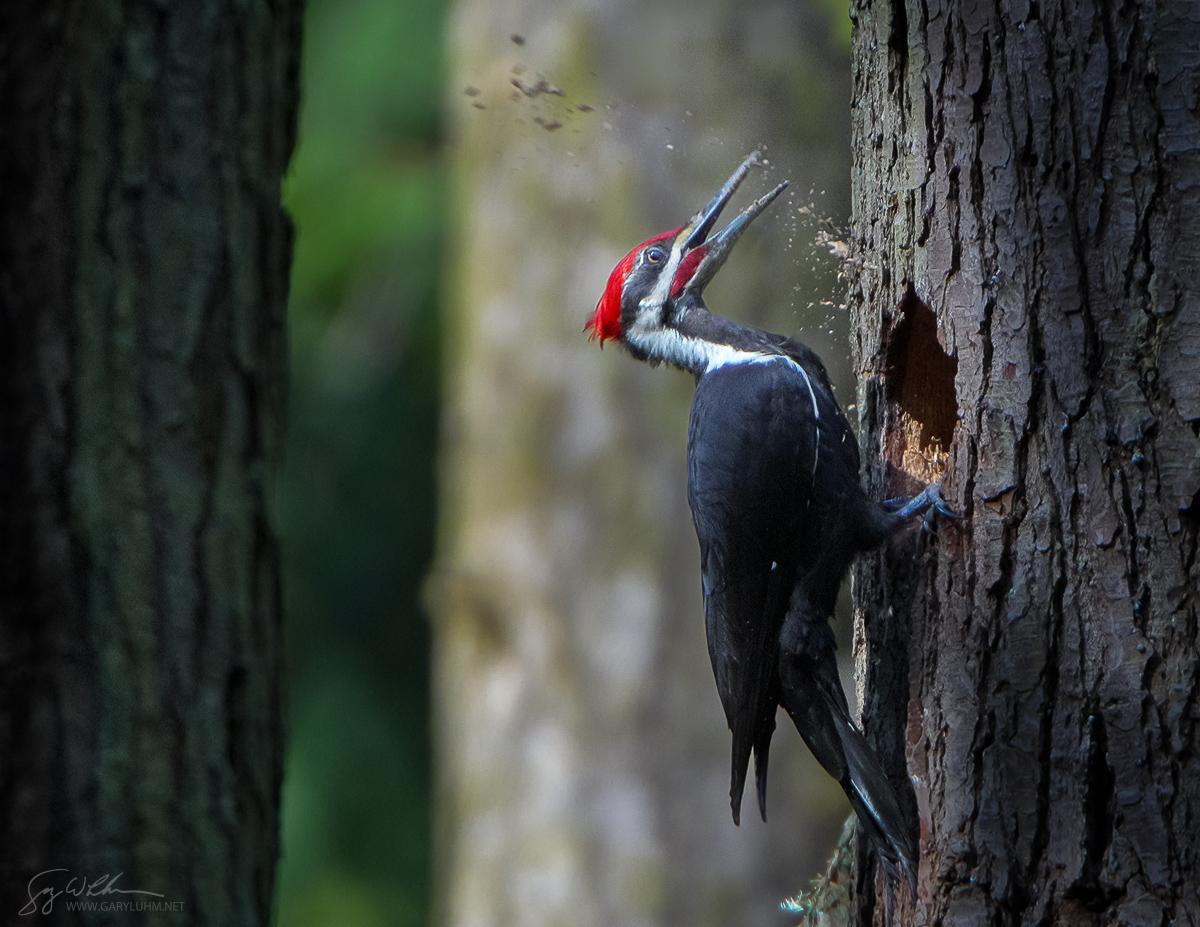
Early Prospecting. On an early spring walk in a local park, I heard a thumping overhead. Woodpecker! Sure enough, a male Pileated was perched up a Douglas Fir snag, hammering a fresh hole. I returned the next day to find the female at work, a good sign. I gave them a couple days to further commit, and then returned with tripod and my longest lens. Cautiously, I set up at a distance, with some cover behind a cedar tree. My position lined up columnar adjacent trees that created strong vertical lines. This image caught the male, still working from the exterior, ejecting woodchips. I love the perspectiveꟷthe strong verticalsꟷimposing and fitting for our largest and most stately woodpecker. The shaft of sunlight on the bird was an unexpected bonus, yielding a chiaroscuro feel.
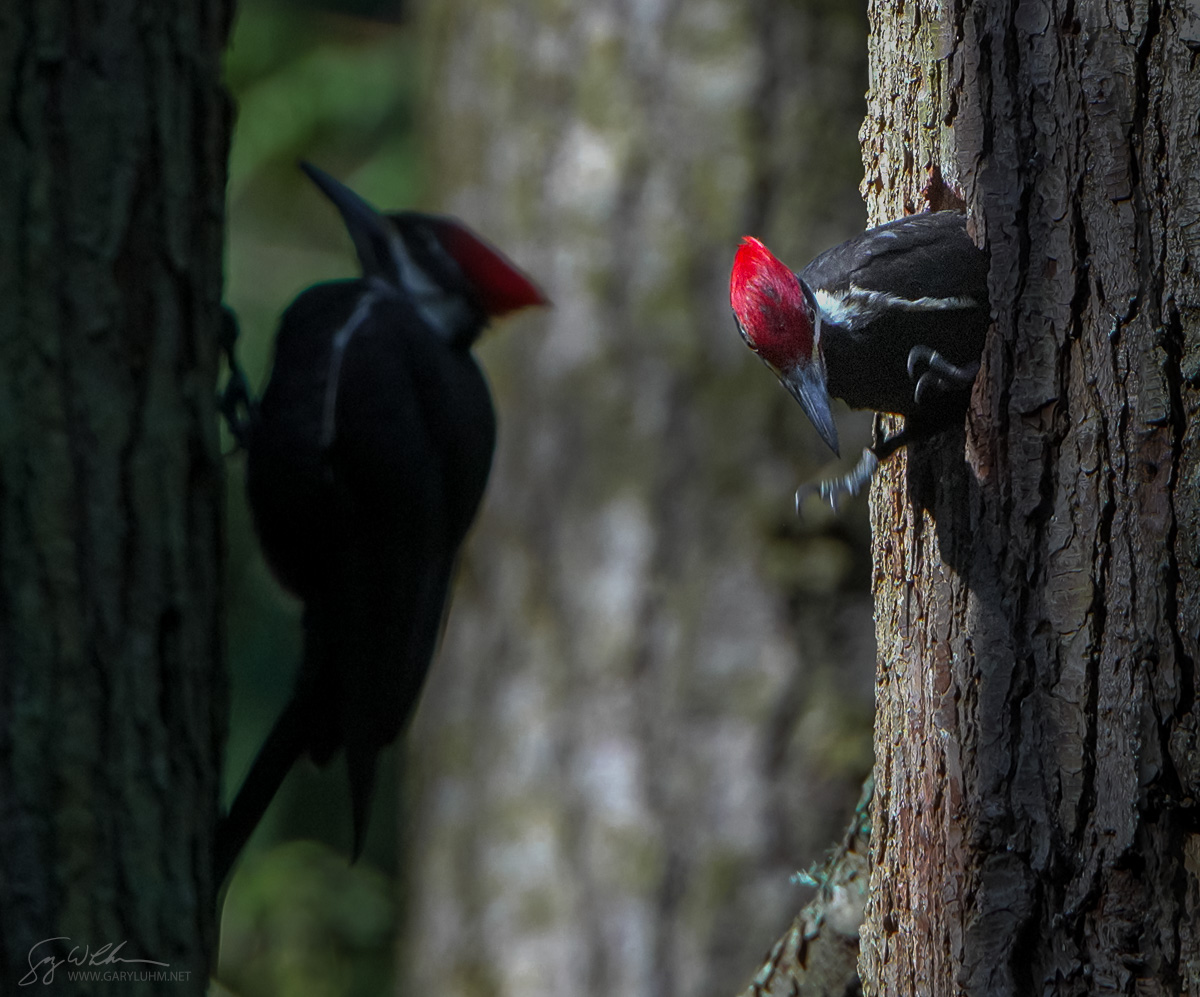
Lucky Bonus. Same shoot as above, the female landed on an adjacent snag and preened while the male slipped inside, perhaps to inspect his work or to demonstrate progress. Nice to catch the birds together. He departed and she set to work on the hole.
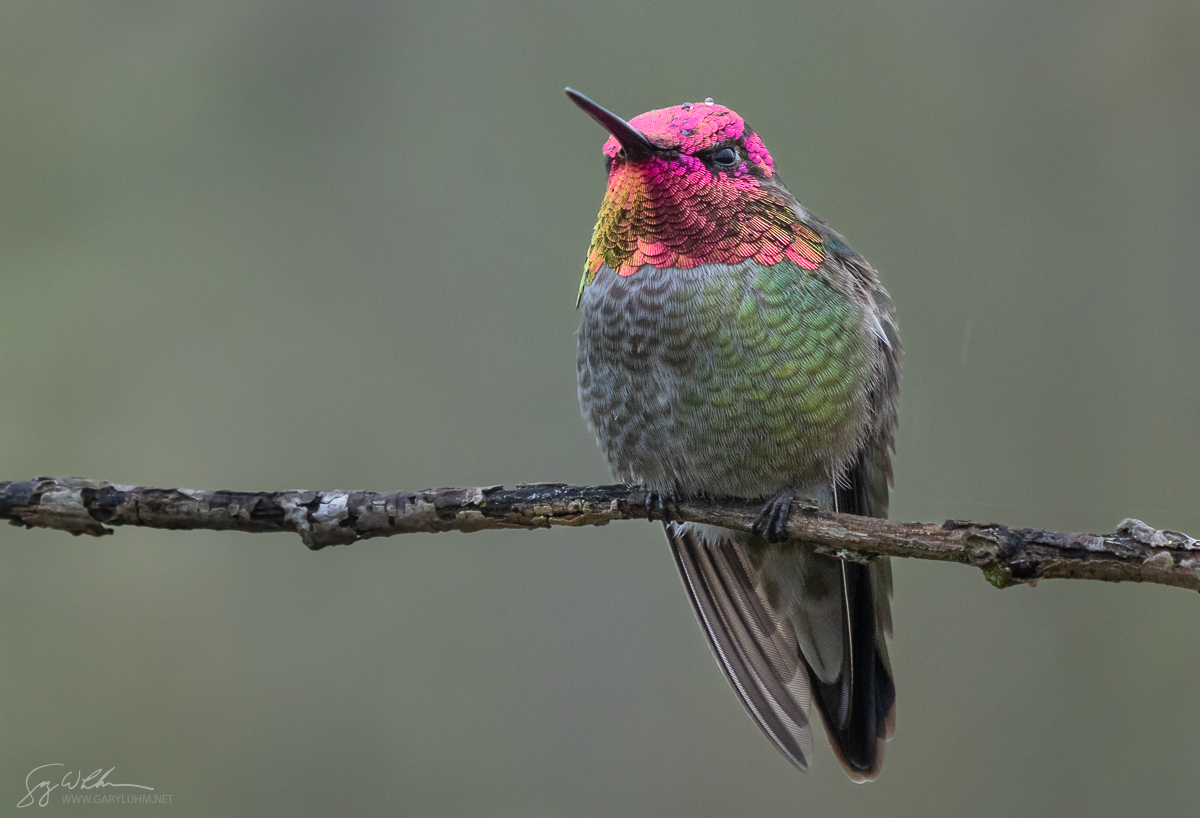
Serendipity. Kate and I did a marsh bird survey (Puget Sound Bird Observatory) in drizzle on an April morning, at Totem Lake. Survey done, while walking out this male Anna’s Hummingbird landed on a low willow branch in front of us. I love the dead perch here, just the right-size for the hummer’s tiny feet. And, of course, the flashing gorget.
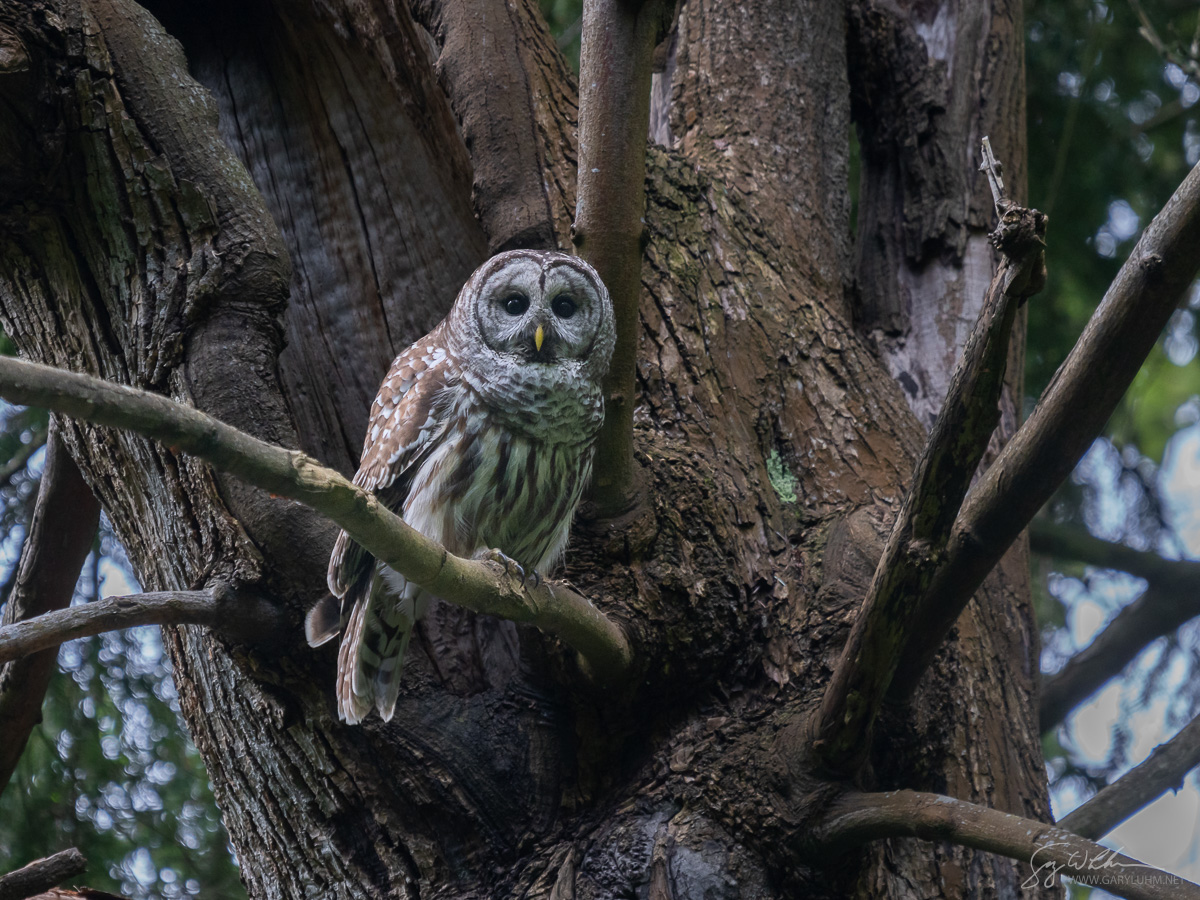
Discovery. After several days looking for Barred Owl nests in nearby parks, mobbing robins alerted me to this one. After capturing this image, I moved away down the trail. As I watched from a distance, the bird, which proved to be the female, spent a bit of time preening, and then disappeared into the tree cavity behind. I could still see her tail feathers as she settled down in the nest, and, given the April timing, probably brooding chicks.
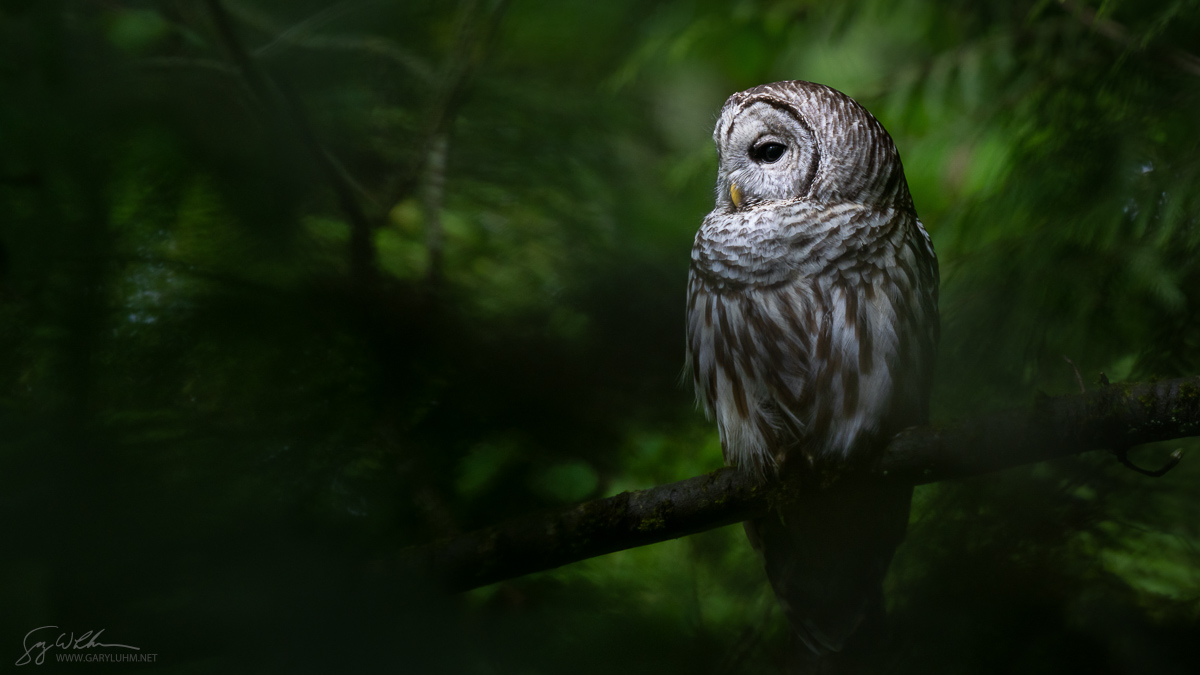
Finding Bokeh. A while later the same day, not far from the nest, I was startled to look up to a male Barred Owl on a low trailside perch. I was quite close, but the background was busy. I stepped back on the trail and found a small opening through cedar branches. The new perspective blurred foreground, shifted background to a wash of green, and, crucially, created mystery. A window of skylight lit up the owl, another chiaroscuro effect.
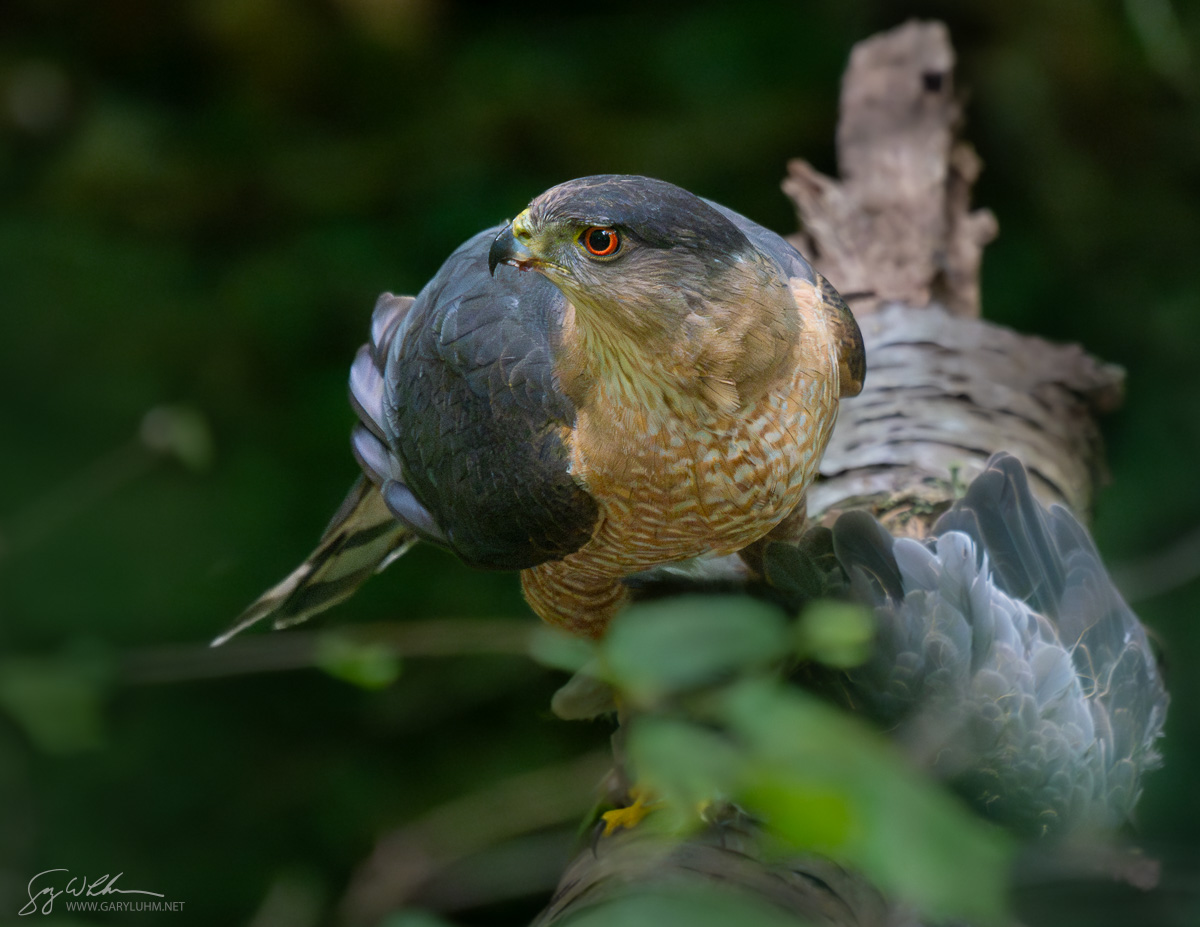
A Quiet Forest. In May, I biked to St. Edwards State Park, intent on photographing Anna’s Hummingbirds that in the past frequented an Orange Honeysuckle patch. The Honeysuckle flowers were many, and in perfect condition, but the birds weren’t showing. Non-the-less, it was a joy to stand or sit, listening to the forest speak with so little city noise. Ravine trails in St. Edwards are like that, such a gift in our urban environment. Suddenly, I heard a distinct, nasal croaking sound, repeated, then silence. Raptor? I stepped down the trail, peered over the edge and discovered a Cooper’s Hawk on a kill. I fired a dozen shotsꟷno time to change settings for the darkness below. A passing hiker caused me to pause; the hawk flew off. The kill was a pigeon, maybe Band-tailed; the Cooper’s Hawk probably the female of a mated pair. There were no plucked feathers on the log, but twenty feet away down on the ground, feathers everywhere. I think the maleꟷcharged as he is with hunting dutiesꟷprepped the (heavy) kill on the ground. The female took possession and flew to the log, where I found her.
In post, I found I was under-exposed 2-½ stops. Thankfully, the dynamic range of today’s cameras made recovery possible. In Lightroom, Enhance Denoise helped make magic.
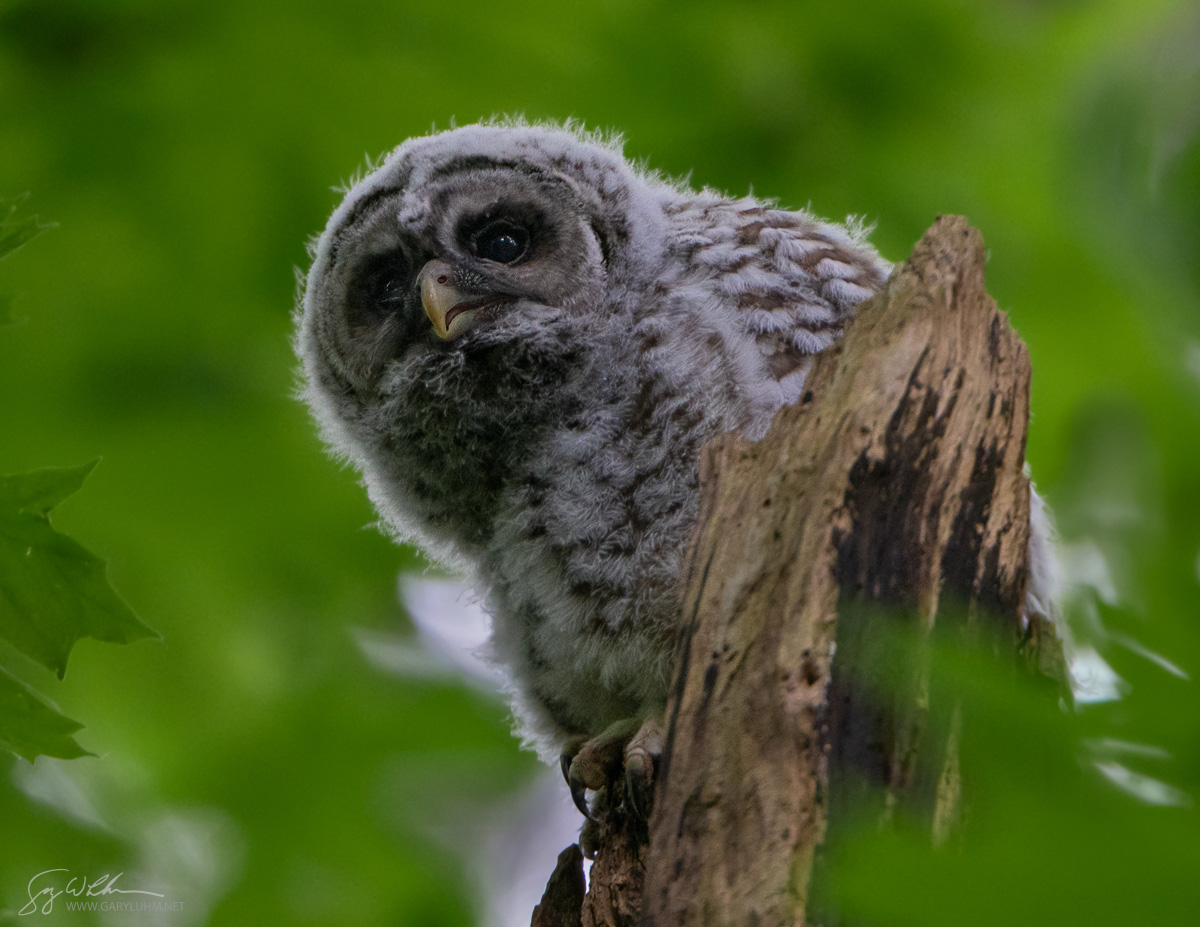
Owlet. End of May, the third of three Barred Owl owlets emerged from a nest. The bird climbed up a dead-end limb where it paused long enough for me to set-up below, 500 f4 and 1.4x on a tripod, and manually focus. The youngster nearly filled the frame, with a slow shutter speed (1/80s) for the 1050mm equivalent lens.
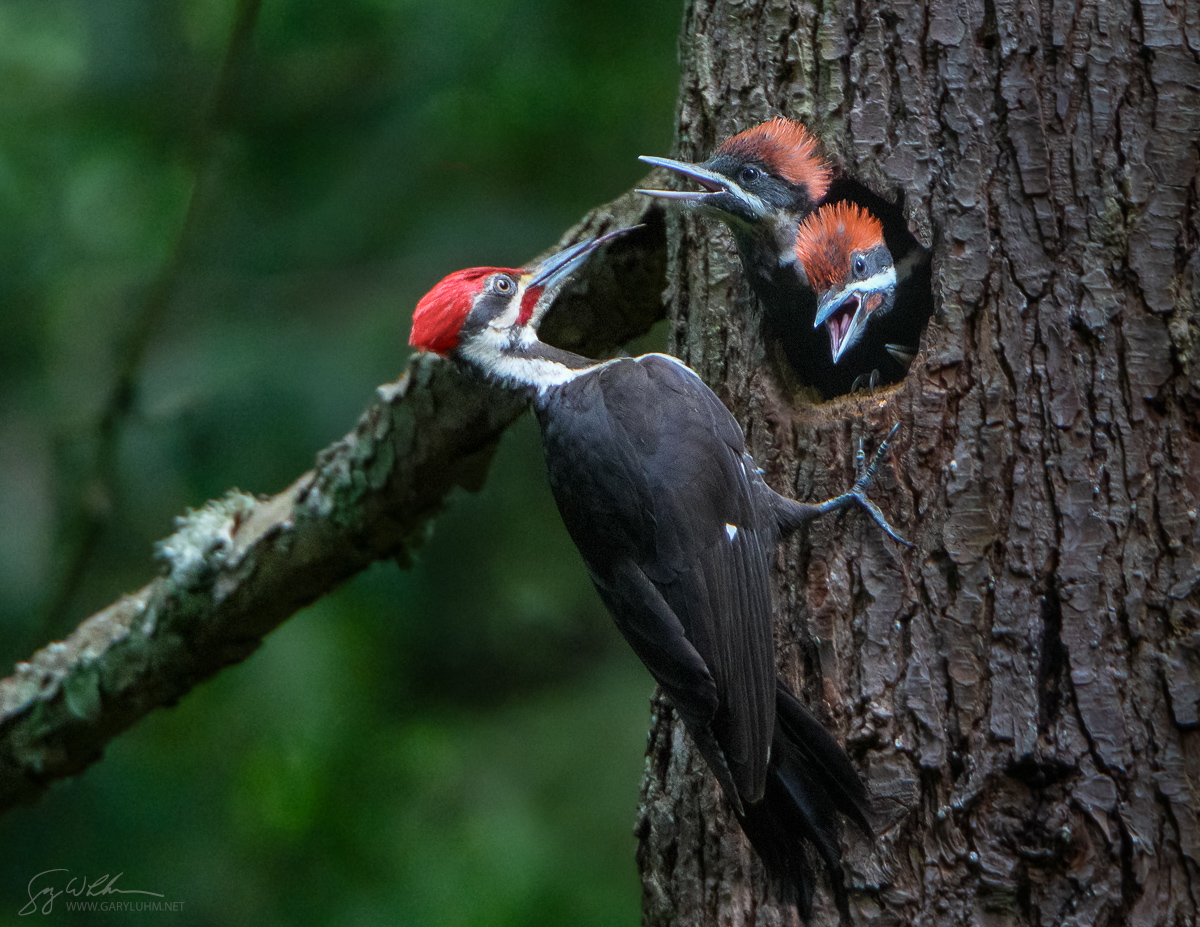
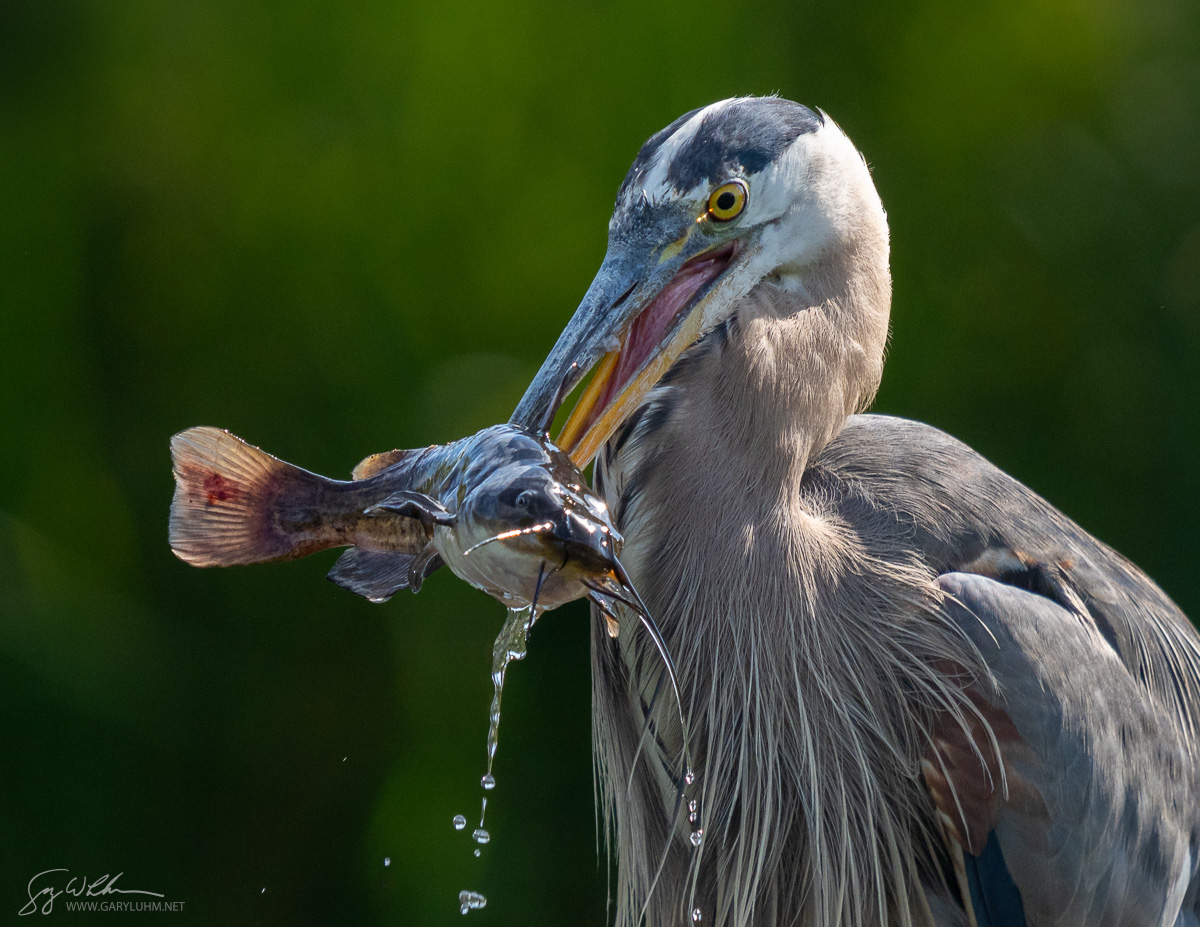
Catfish. A common prey for Great Blue Heron in Union Bay is catfish. By kayak, I was approaching the end of my paddle when this heron, fish in bill, flew towards me, banked and landed on a mud mound in the middle of Duck Bay. Wow. With no nearby shore, this was an opportunity to catch some action with a distant background! Great Blue’s are big birds as well, a close approach neither desired or needed. A couple paddle strokes, and I firstly got backlit shots while the heron dropped and pierced its prey. Then, taking a chance, I paddled past the bird, lined up side-lit with another pleasing background, and captured dozens more images before the bird swallowed its catch.
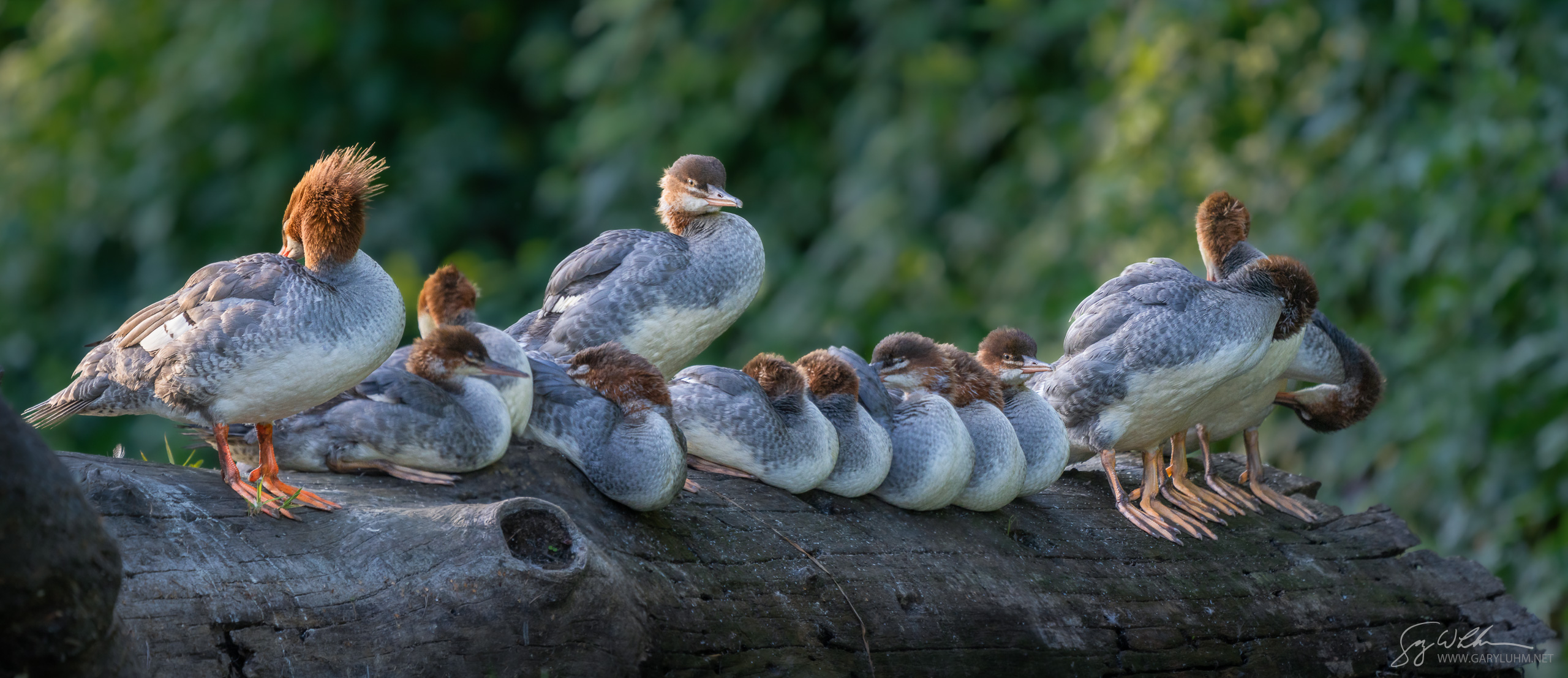
Creche. I was stretching my kayak workouts on the Sammamish River, starting from Bothell. Paddling past the brief swift water where Little Bear Creek enters the flow, I came upon a creche of Common Mergansersꟷ12 kids and a female guardian. I was cautious about approaching them. Soon enough, they floated downstream, diving and hunting, a few of the young birds scoring small fish. Then quickly, they all clambered up on a log for a rest. A best perspective on the group was from below, but the bank prevented me from lining up perpendicular. I thought of stopping down (a lot), but then the background would be busy. I decided on a pan of three shots, changing focus with each. In Lightroom, Photo Merge Panorama failed, so I exported to Photoshop and manually constructed the files. For a bigger view, right click and chose “Open image in new tab” then click on the new tab.
I felt good about discovering this creche, even more so after the following day.
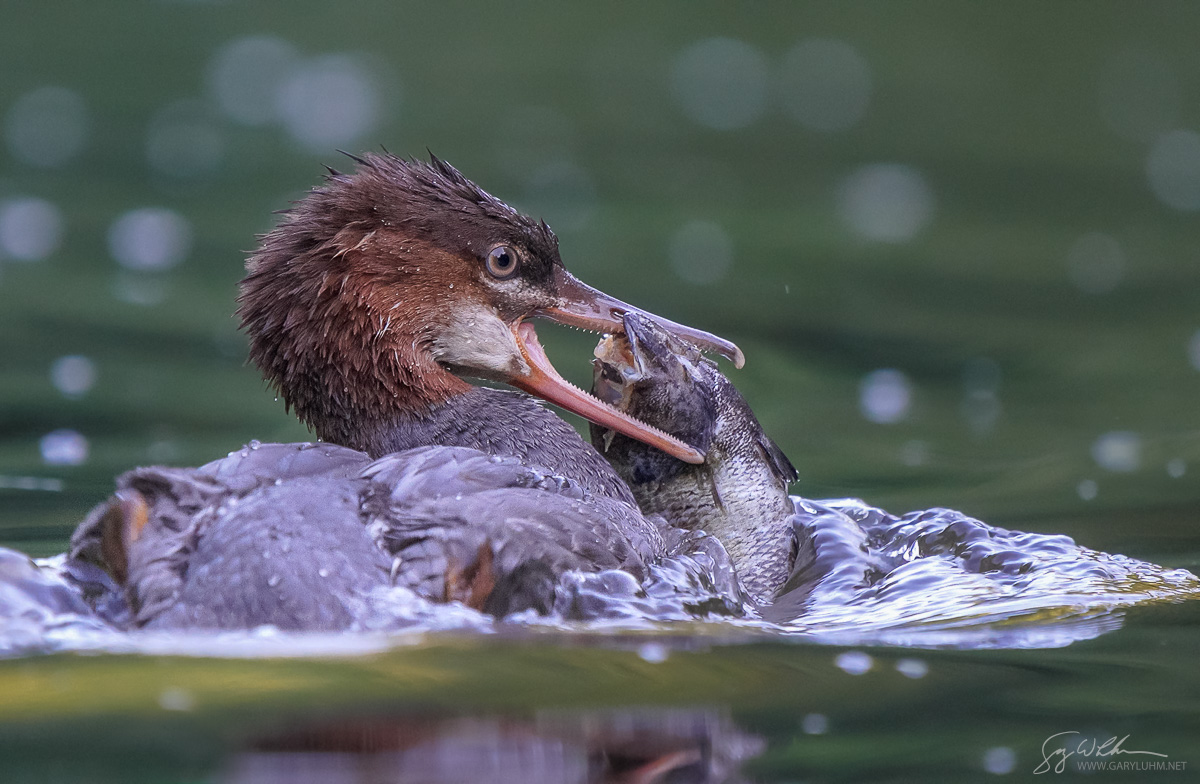
Shad Catch. Returning the next morning, I paddled upstream of Little Bear Creek again and eventually found the creche. The merganser kids alternated between fishing and resting, with the resting just huddling together floating next to sleepy-eyed mom. Soon enough, they would start again, diving for fish. When a kid caught a small one, it was swallowed quickly. If a kid caught a big fish, a chase ensued, with body-surfing kids chasing the show-off, sometimes stealing the catch. Great fun to watch. I shot some jerky handheld video, but I have to say without it I couldn’t have deciphered the action. I wondered if the creche stayed in the river because of the protection from (or lack of) predators it offers, as well as adequate food. Anyway, the shot here is a juvy with what appears to be a beat up, non-native American Shad, a fish becoming more numerous in our waters. According to WDFW, shad feed primarily on plankton; potential effects on salmon, trout, and steelhead populations are unclear.
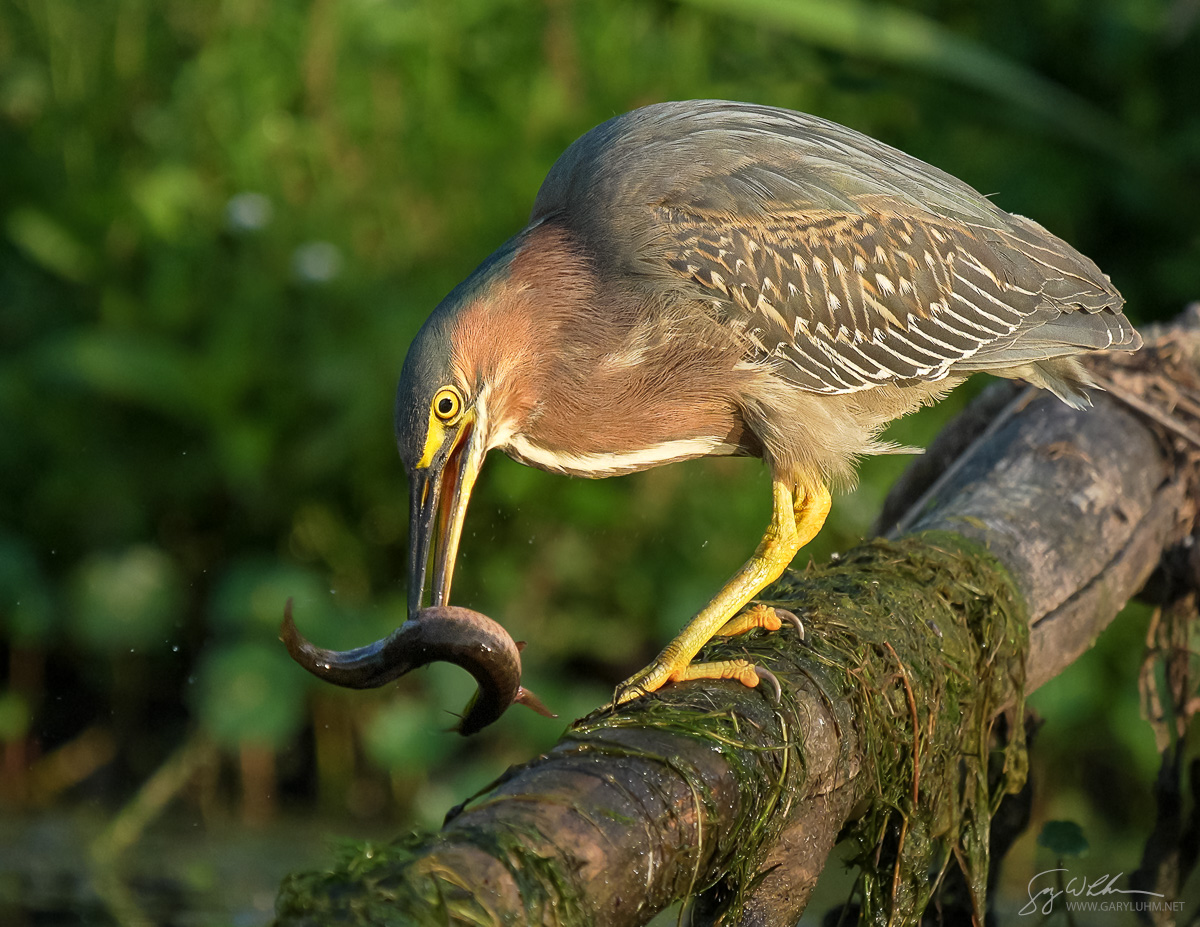
Squirming Weatherfish. When a juvy Green Heron caught this fish on Union Bay in July, I crouched low and pushed the video button, set 4k @120 fps. On the Sony A6700, this crops the sensor a full 1.58x (good in this case), but my shutter speed was so fast, it ruined the video. No worries, the stills I extracted were fabulous in the warm morning light. I brought a prime select into Photoshop and combined it with another that gave me a bit more canvas above the bird, which also allowed a better-composed 4:3 crop (the video 16:9).
Confused by the prey’s whiskers, I wondered if this was a walking catfish of some sort, so I contacted Dennis Paulson and Larry Hubbell. They both replied that they had researched this same fish a few years ago and discovered it was an Oriental Weatherfish (Misgurnus anguillicaudatus), and, as Dennis said, “a kind of loach, not a catfish.” It has also become “an important food source for Pied-billed Grebes.” Dennis stated the fish got there due to “thoughtless pet owners releasing them to the wild.” Agh! Looking back at old files, I found I had photos of Pied-billed Grebes that had indeed caught these invasives, including feeding them to their growing young.
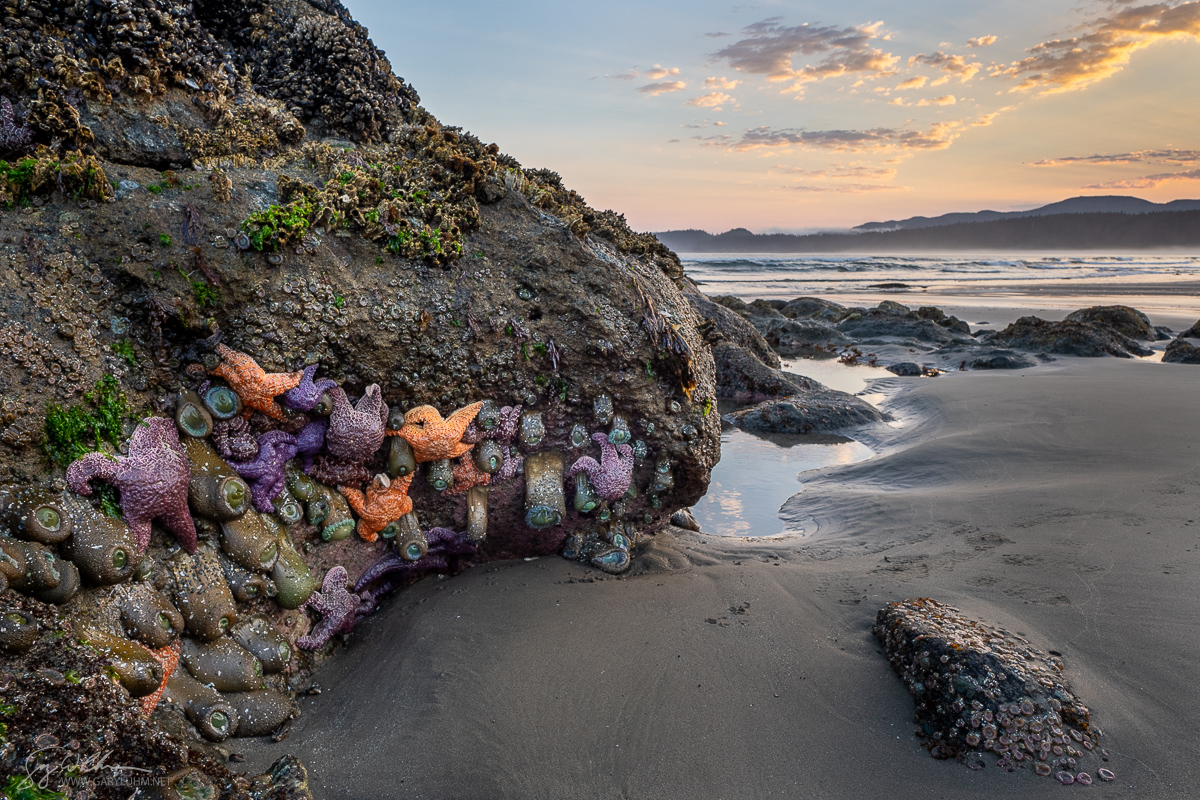
Intertidal Bliss. On 8/1 we hiked to Shi-Shi beach and Point of Arches on the Olympic Coast, timed for early morning minus tides. In our two-night stay, we had one lovely sunrise; our sunsets fizzled. Each dawn minus tide was joyful, so much life: scores of Ochre sea stars amongst anemone, sea lettuce, kelp, barnacles and mussels. Although we saw no Sunflower stars, the Ochre stars here have prodigiously recovered from the wasting disease of a decade ago. This image is a HDR composite from two separate exposures, one for rock face, the other for sky.
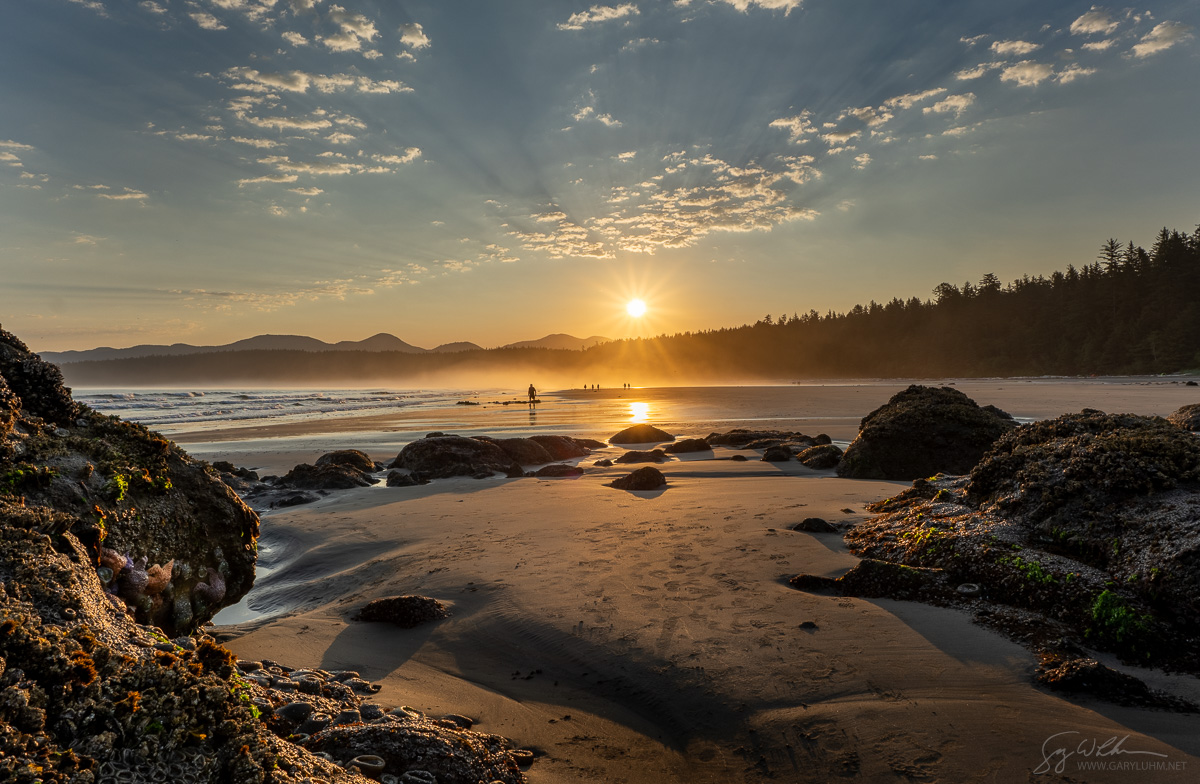
Sun Star! Immediately after the last photo, I re-positioned the tripod, stopped down a bit to increase the sun star effect, framed the sun close to the middle to reduce flare and shot a wider range of exposures to combine later (HDR) in Lightroom.
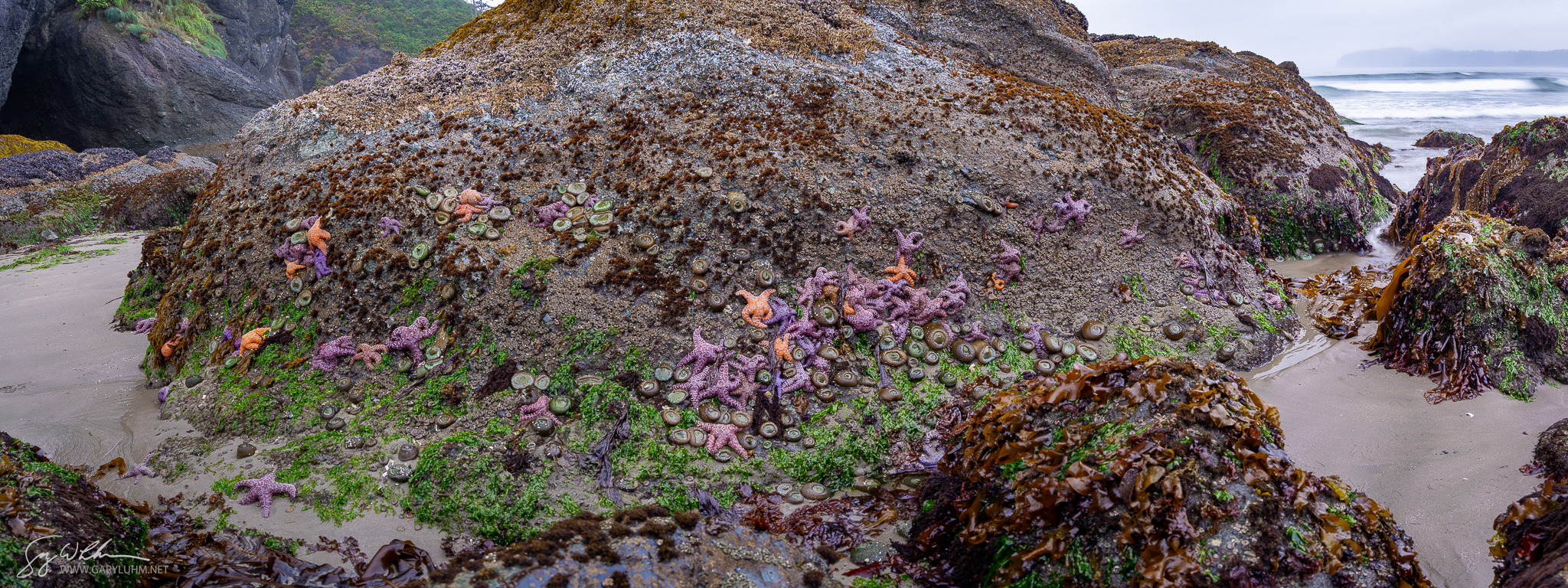
They’re Back! Seeing this wall of sea stars (and anemones) on our second morning at Point of Arches caused me to exclaim, “They’re Back!” I realized, as well, this felt like a homecoming; the first time since 2012 I camped here. It was also the first time by backpack since the early ‘90’s. Since 1994, when I could safely paddle open ocean and handle surf landings, kayaking from Makah Bay to Point of Arches was a faster route and more fun. I wrote in my notes one year that I paddled the return to Makah Bay in a Mariner Coaster in 45 minutes (probably helped by a flood current). This trip the backpack return, 4.5 miles and slowed by the muddy trail, took 2-1/2 hours.
To capture the scene, I leveled the tripod, mounted my wood panorama tool to shoot verticals, practice panned the scene at various focal lengths, chose 25mm, and then shot 7 sets of 5 exposures, with good overlaps. In post, I picked two exposures to represent the shot, and Lightroom created a smooth composite (HDR panorama). The result was a 91MP image that I cropped just slightly. Best seen big. Right click and chose “Open image in new tab” then click on the new tab.
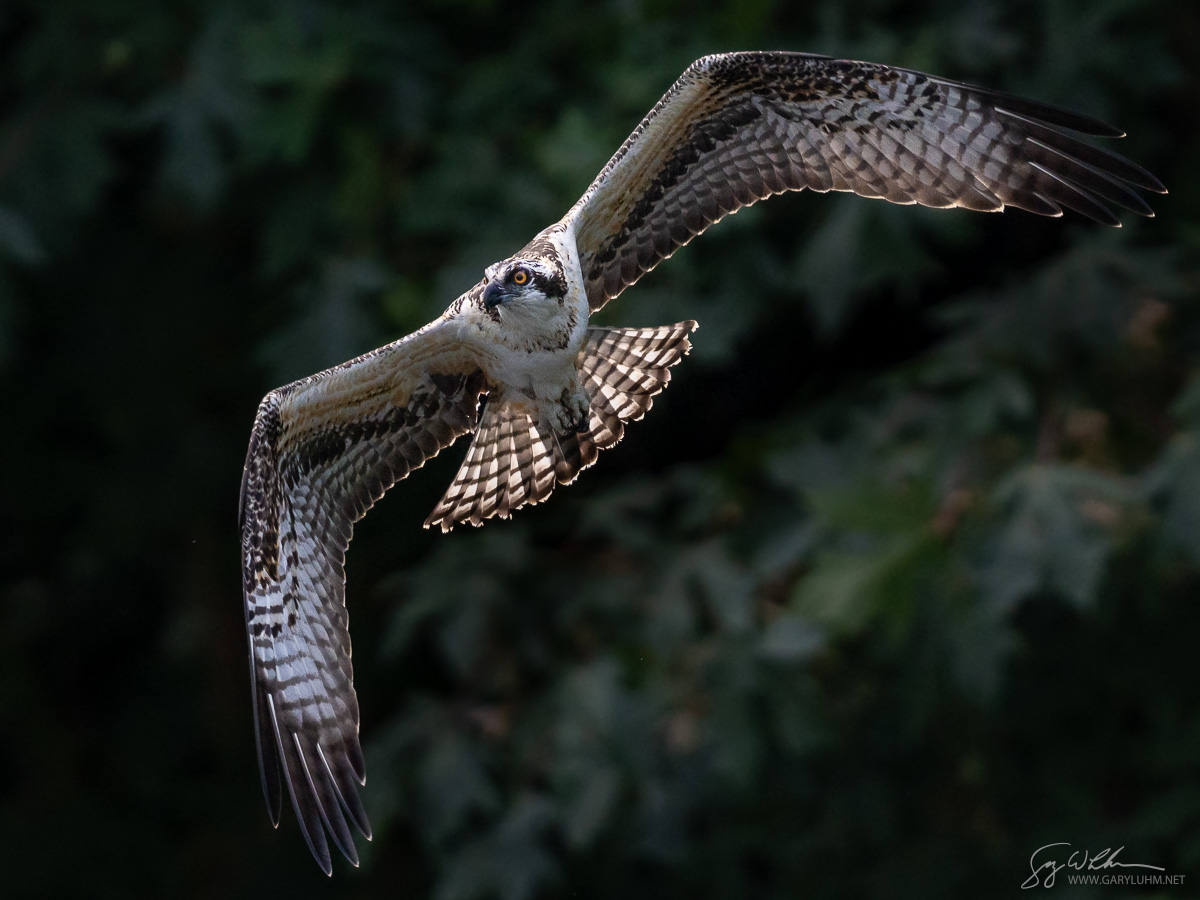
Osprey Schooling. In August by kayak, I came upon a juvy Osprey that hit the water in front of me, not talons out like a hunting adult, but a gentler strike, more like beginner dive practice. When the bird lifted off, it angled towards me, giving me this look before a turn back upriver. Bright overcast light and preset exposure settings sealed the shot. Also significant, this day marked my second outing using the Sony 300mm f2.8 lens, with a two-stop faster shutter speed for flight shots, improved bokeh and, it seems, faster focus acquisition.
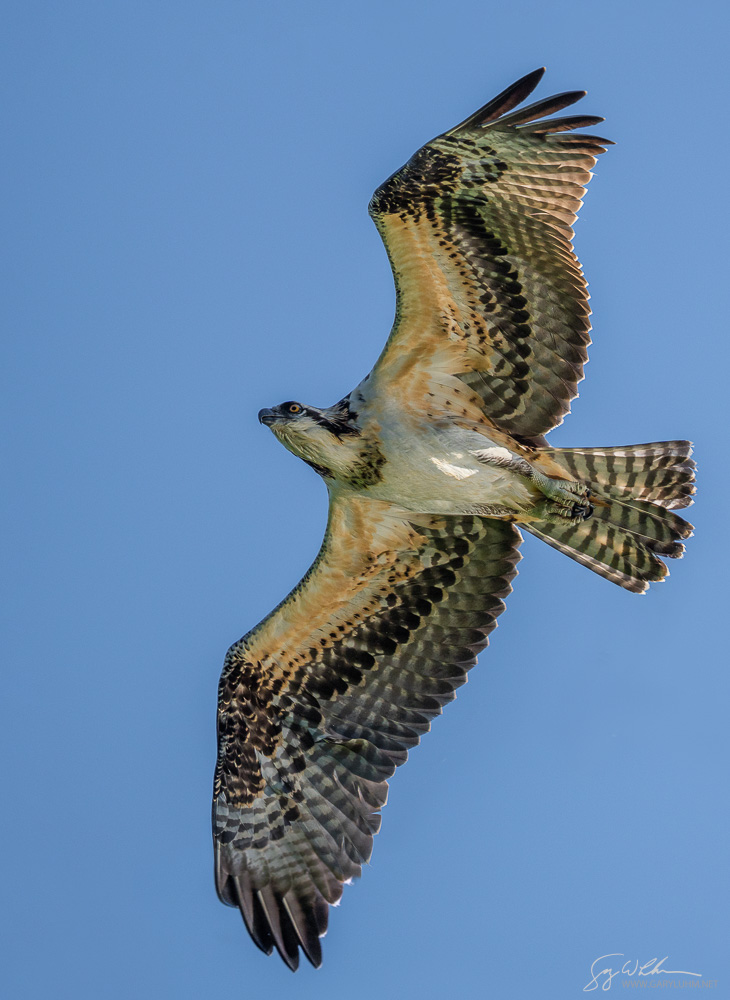
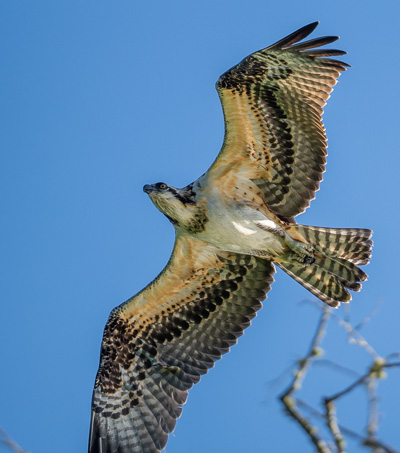
Manual Wing Repair. Early September, I found the juvy Osprey again on the Sammamish Slough near Ti’ awh-ah-dees Park. On this still, sunny morning, the bird was perched rather high, with wet feathers indicating he had missed on any fishing attempts or was maybe still practicing. The bird launched from the perch downward, talons out, but then aborted the dive, circled back towards me and passed overhead so close that I cut off the lower wing on an otherwise decent shot. In photoshop, I expanded the canvass and repaired the wing using the very next image.
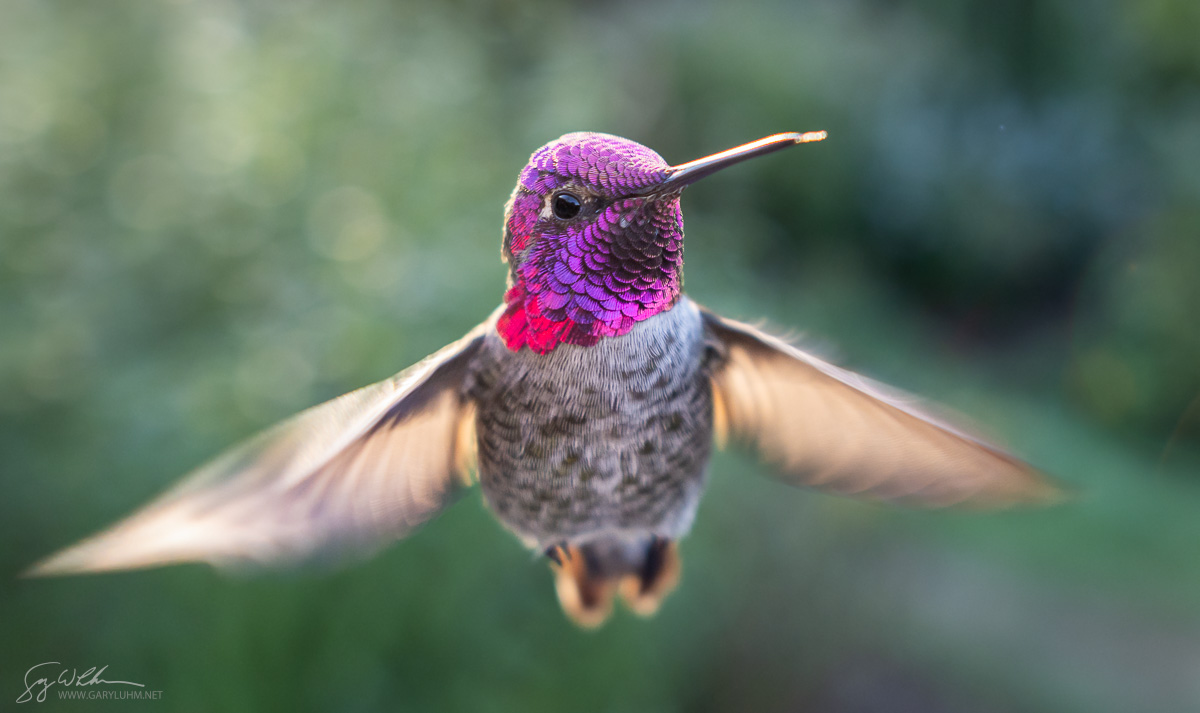
Anna Super Wide. In October I photographed backyard Anna’s Hummingbirds using a wide-angle, 15mm f1.4 lens, controlled with the Sony Creators’ phone app. My shoot strategy was to force visiting hummingbirds to hover by replacing our three-hole perching feeder with a sugar-water-filled spice container (See Wide-angle Lens for Hummers), camera just inches away on a tripod. I stood behind our glass door inside the house, firing the app trigger when a hummingbird arrived. Results exceeded expectations. Often, when the bird backed away from a feeder hole, it would hover facing the camera, and the auto-focus worked to deliver a sharp eye. The background became a pleasing bokeh, but not a plain wash that a telephoto would produce. On sunny October mornings, the sun pierced the neighbors Douglas Fir, sometimes backlighting the scene without significant flare, as in this particular shot. I should note I used the camera’s electronic (silent) shutter. The close proximity mechanical shutter chased the bird off like a shotgun blast.
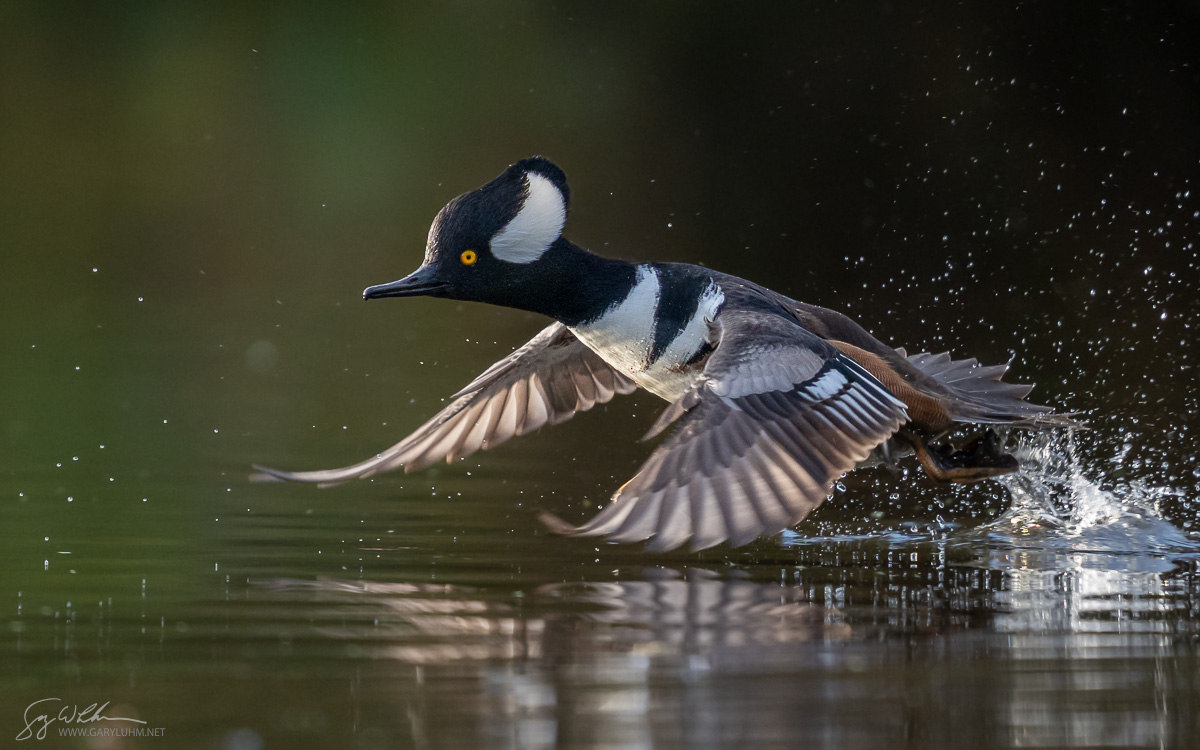
Hoody! By late October, many wintering ducks had returned to the Sammamish Slough. I got lucky when a rainy forecast had sunbreaks, and a recent-arrival trio of Hooded Mergansers broke in my direction. The Sony A6700 with 300mm 2.8 lens wide open picked this male up and nailed the focus for a half-a-dozen frames. Being able to shoot at f2.8 means faster shutter speeds, quicker auto-focus and better bokeh.
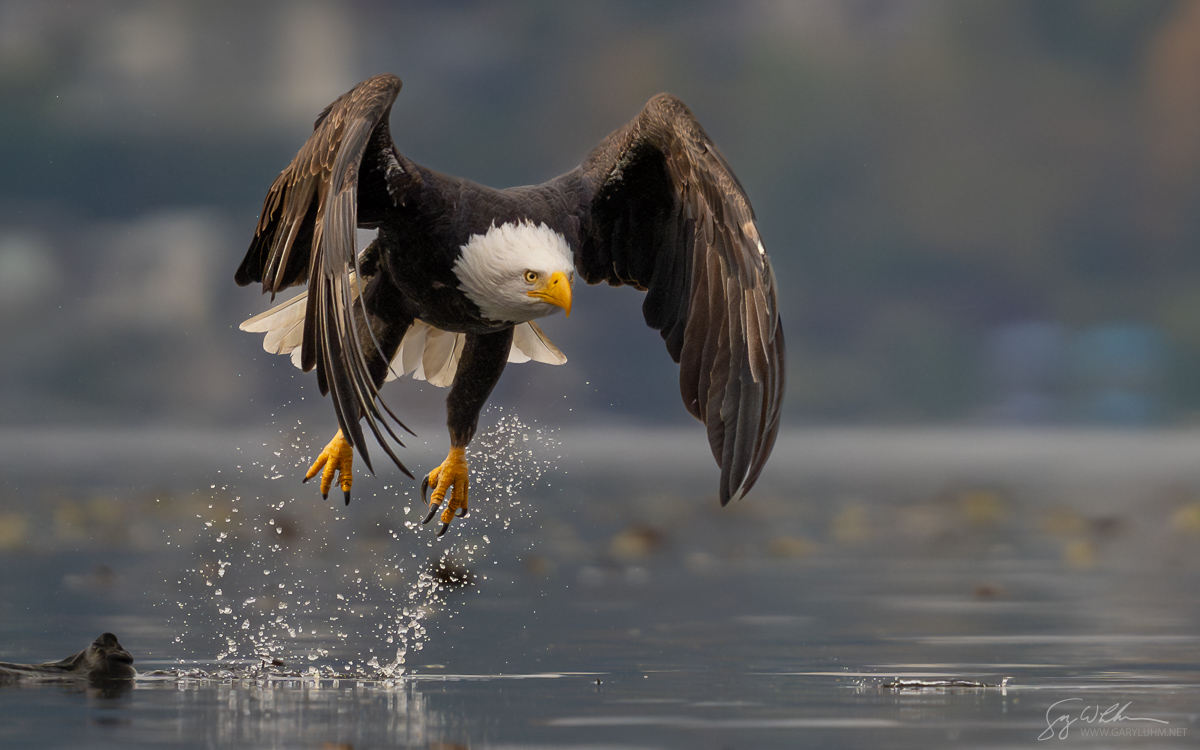
Frozen Eagle. Same morning, a Bald Eagle perched on a submerged log, possibly cleaning up after feeding. I got some snapshots, but didn’t like the background because of a shoreline pier. So I backed up diagonally for a different angle (and background). When the bird lifted off, the frozen spray and the wing shape won the day. F2.8 kept the distant Lake Washington shore a pleasing blur, a barely noticeable cityscape.

The set-up was routine: a horizontal panorama from three sets of three exposures each. Lightroom combined them flawlessly, followed by a bit of dodging and burning. View it big by right clicking and chose “Open image in new tab” then click on the new tab.
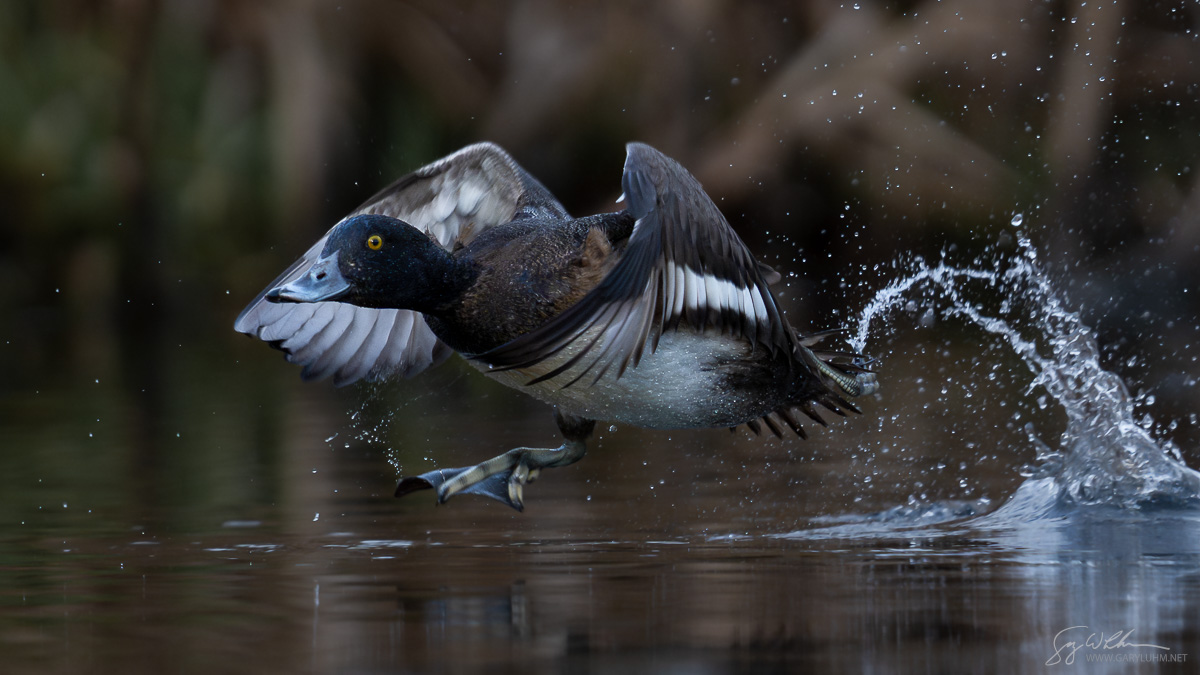
Scaup. I got lucky on a cold, rainy December weekday when the sun broke out low in the southeast. As I launched my kayak from the Kenmore floating dock, Lesser Scaup, Common Mergansers and Common Goldeneye were nearby, an indication that boaters weren’t on the water as these birds are skittish. Paddling upstream, a pair of Scaup got my attention. I lingered from a ways off. When they didn’t fly, I angled the kayak to give them space to my left if they flew towards me, which they both did. The male chose a close flight path, and I picked him up early, getting half-a-dozen sharp shots. Wing position was key in selecting a favorite; the bird’s dark head surrounded by light tones a bonus. I like the extended webbed foot too, and the implied action of the water spray.
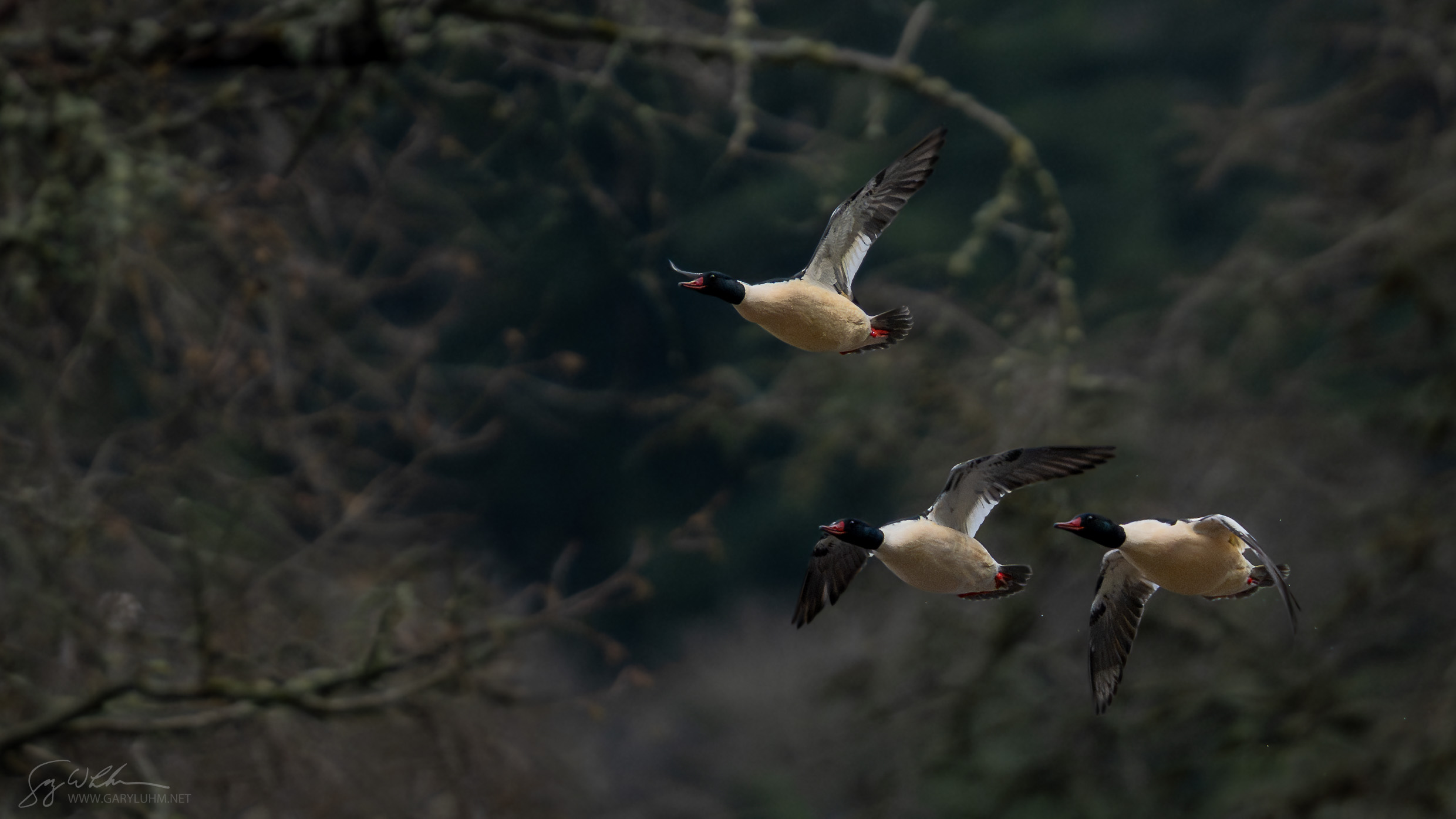
Winterish Birdscape. Weekday morning, I paddled the Sammamish Slough again, with decent light. A male trio of Common Mergansers took flight towards me from a long ways off, probably done with fishing. Lucky for me, they passed by against a dark green backdrop. The number three is a great compositional element, the birds nicely spaced with no overlap, and the curving tree branches frame the birds in this birdscape. View it bigger by right clicking and chose “Open image in new tab” then click on the new tab.
Looking ahead to 2025, I will again be teaching “Composition in Bird Photography” at the May 15-18 Leavenworth Spring Bird Fest; schedule not yet posted.
Thanks everyone for looking.
Comments appreciated,
Gary

Wonderful photos, Gary, and thanks for the commentary. That was definitely a Band-tailed Pigeon. Cooper’s Hawks go after them in our yard in Seattle, and I have witnessed and photographed four kills. Female hawks can fly with them, but male hawks, not much different in size from the pigeons, apparently can’t.
Thanks, Dennis! Of course, I didn’t see the male, but from what I heard and observed, the female w/Band-tailed seems likely.
Beautiful images Gary! Love the low angle of view that you can get in your kayak!
Thanks, Margaret! Hope you’re getting out photographing. I’ve seen spectacular scenics from you this year!
Just amazing. Awesome captured of the birds. I love the iridescence hummingbirds.
Thanks, Felicia. Hope you’re still paddling!
Yes I am. Can’t play as usual in the surf any more.
Same with me.
As always, stunning photos!
Thanks, Nancy. Loved your Christmas card!
Remarkable photos, Gary! Thank you for sharing them along with the stories behind them.
Thanks, Lin. I’m sure you’re out exploring and photographing the planet! Hi to Sam.
absolutely lovely brother.I salve my saddened heart with memories of when I could paddle the home made `kit` skiff low to the water and silent.The road where we scattered the ashes of your brother is no longer maintained and thus impassible.I would recommend renewing Kate`s contract.She is truly a keeper.
Hey Mike! Contract renewed! Sorry to hear about the road. I’m sure Bob loves the solitude, the peace.
Hi Gary, Thanks for sharing these wonderful photos and descriptions with us! Wishing you a very Happy New Year! Smiles, Carla
Gary, Wonderful, As Always. Not only technically correct, the art is fabulous. You won’t need to purchase an EV……just keep
using Peddles and Paddles. Happy New Year!
Haha about the EV. I was telling Kate the old Honda is the last remaining stealth vehicle. It can’t be tracked or hacked.
Thanks, Andy. Peddles and paddles keeps me going! Simplicity! Occam’s razor reigns!
As someone who loves bird photography but finds the editing process a drudge I appreciate the time & effort you take in editing and sharing your fav photos every year! I remember when you ditched Canon and upgraded to Sony so I keep thinking I should do the same but find myself stuck in a rut (partly by inertia but mostly by my numerous lenses) and just keep upgrading to Canon’s latest & greatest in the hope that some magic will happen.
I’ve always said it doesn’t matter what gear you have, though it does matter as to the kind of images you can capture. Much of the rest is up to imagination, learning birds and work. The newer cameras (with bird eye recognition, etc) do allow a higher percentage of keepers. I’m lucky that by kayaking I do get a different look at the world.
Thanks Gary. Terrific photos. Your skill is admirable. I should take the composition workshop. Maybe I’ll see you there.
Andy, thanks so much. Composition is a big, underrated, piece of the bird photography puzzle. A practical thing about it is it’s universal, mostly unchanging, unlike the latest camera gear.
Gary, it’s nice to see our shared community through your eyes! Let’s paddle sometime this Spring. Happy New Year and stay safe.
Paddling makes us strong!
Dear Gary: I always learn something from seeing your wonderful images. Thank you. Happy 2025! Be well, SAM
Thanks, Sam. Was such a pleasure meeting you on that rainy trip to Blackfish Sound.
All I can say is: WOW, WOW, WOW!!! Your photos are incredible & I love the narrative of how you came upon the subjects & captured the photo. You have an amazing eye! I would love to be on your mailing list- I so enjoyed your pictures from 2024!
Missy
Glad to see you’re still producing absolutely amazing shots. Any of these would be a lifetime best for me. I really like your commentary.
Thanks so much, Larry. Hope you’re getting out photographing. We have a new photo group lead, Leah. Lots of new faces.